AMD's Radeon HD 6970 & Radeon HD 6950: Paving The Future For AMD
by Ryan Smith on December 15, 2010 12:01 AM ESTPower, Temperature, & Noise
Last but not least as always is our look at the power consumption, temperatures, and acoustics of the Radeon HD 6900 series. This is an area where AMD has traditionally had an advantage, as their small die strategy leads to less power hungry and cooler products compared to their direct NVIDIA counterparts. However NVIDIA has made some real progress lately with the GTX 570, while Cayman is not a small die anymore.
AMD continues to use a single reference voltage for their cards, so the voltages we see here represent what we’ll see for all reference 6900 series cards. In this case voltage also plays a big part, as PowerTune’s TDP profile is calibrated around a specific voltage.
| Radeon HD 6900 Series Load Voltage | ||||
| Ref 6970 | Ref 6950 | 6970 & 6950 Idle | ||
| 1.175v | 1.100v | 0.900v | ||
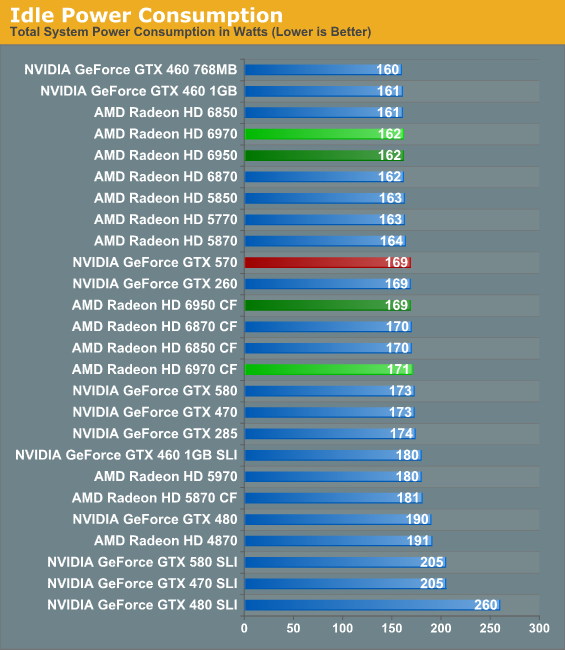
As we discussed at the start of our look at these cards, AMD has been tweaking their designs to take advantage of TSMC’s more mature 40nm process. As a result they’ve been able to bring down idle power usage slightly, even though Cayman is a larger chip than Cypress. For this reason the 6970 and 6950 both can be found at the top of our charts, running into the efficiency limits of our 1200W PSU.
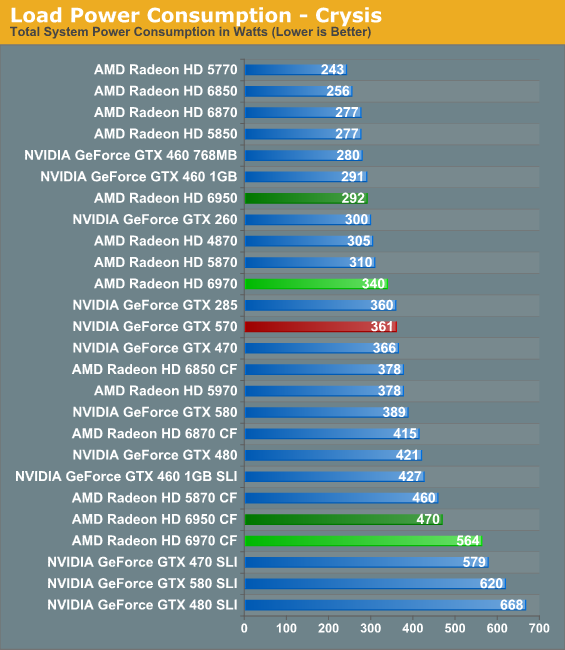
Under Crysis PowerTune is not a significant factor, as Crysis does not generate enough of a load to trigger it. Accordingly our results are rather straightforward, with the larger, more power hungry 6970 drawing around 30W more than the 5870. The 6950 meanwhile is rated 50W lower and draws almost 50W less on the dot. At 292W it’s 15W more than the 5850, or effectively tied with the GTX 460 1GB.
Between Cayman’s larger die and NVIDIA’s own improvements in power consumption, the 6970 doesn’t end up being very impressive here. True, it does draw 20W less, but with the 5000 series AMD’s higher power efficiency was much more pronounced.
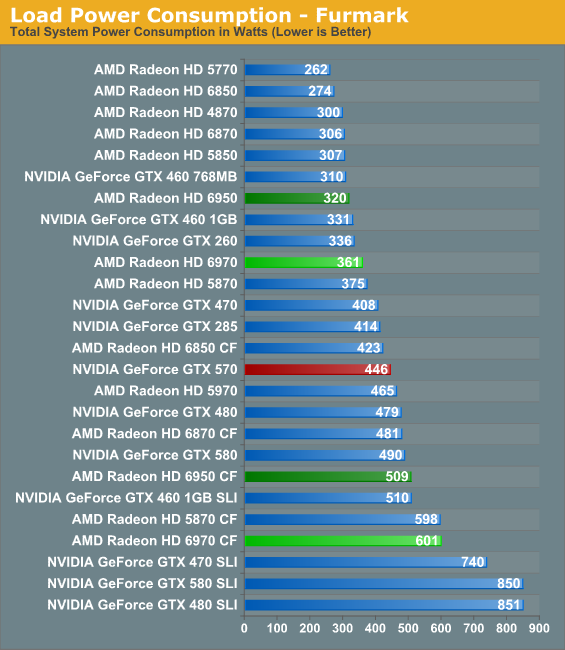
It’s under FurMark that we finally see the complete ramifications of AMD’s PowerTune technology. The 6970, even with a TDP over 60W above the 5870, still ends up drawing less power than the 5870 due to PowerTune throttling. This puts our FurMark results at odds with our Crysis results which showed an increase in power usage, but as we’ve already covered PowerTune tightly clamps power usage to AMD’s TDP, keeping the 6900 series’ worst case scenario for power consumption far below the 5870. While we could increase the TDP to 300W we have no practical reason to, as even with PowerTune FurMark still accurately represents the worst case scenario for a 6900 series GPU.
Meanwhile at 320W the 6950 ends up drawing more power than its counterpart the 5850, but not by much. It’s CrossFire variant meanwhile is drawing 509W,only 19W over a single GTX 580, driving home the point that PowerTune significantly reduces power usage for high load programs such as FurMark.
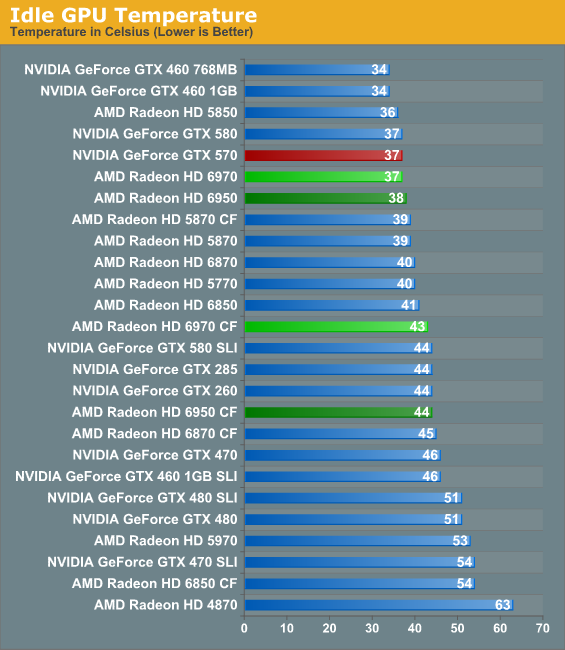
At idle the 6900 series is in good company with a number of other lower power and well-built GPUs. 37-38C is typical for these cards solo, meanwhile our CrossFire numbers conveniently point out the fact that the 6900 series doesn’t do particularly well when its cards are stacked right next to each other.
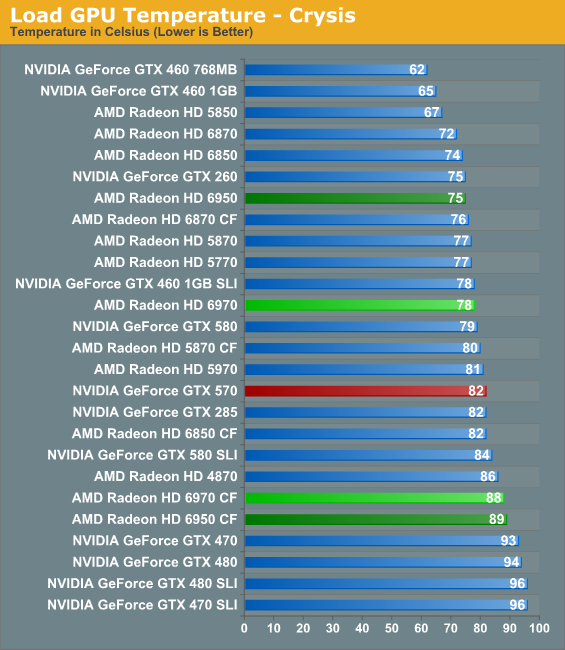
When it comes to Crysis our 6900 series cards end up performing very similarly to our 5800 series cards, a tradeoff between the better vapor chamber cooler and the higher average power consumption when gaming. Ultimately it’s going to be noise that ties all of this together, but there’s certainly nothing objectionable about temperatures in the mid-to-upper 70s. Meanwhile our 6900 series CF cards approach the upper 80s, significantly worse than our 5800 series CF cards.
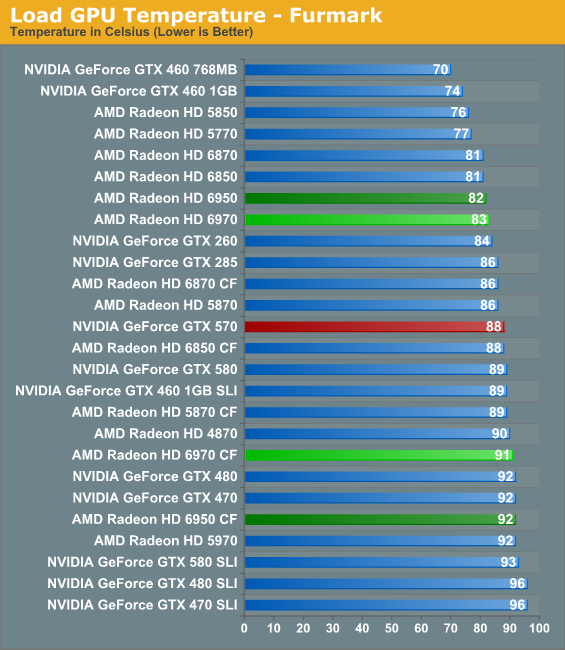
Faced once more with FurMark, we see the ramifications of PowerTune in action. For the 6970 this means a temperature of 83C, a few degrees better than the 5870 and 5C better than the GTX 570. Meanwhile the 6950 is at 82C in spite of the fact that it uses a similar cooler in a lower powered configuration; it’s not as amazing as the 5850, but it’s still quite reasonable.
The CF cards on the other hand are up to 91C and 92C despite the fact that PowerTune is active. This is within the cards’ thermal range, but we’re ready to blame the cards’ boxy design for the poor CF cooling performance. You really, really want to separate these cards if you can.
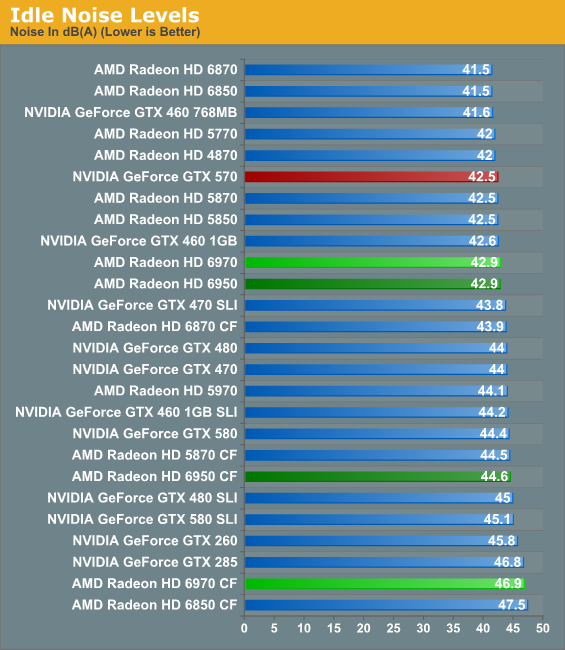
At idle both the 6970 and 6950 are on the verge of running in to our noise floor. With today’s idle power techniques there’s no reason a card needs to have high idle power usage, or the louder fan that often leads to.

Last but not least we have our look at load noise. Both cards end up doing quite well here, once more thanks to PowerTune. As is the case with power consumption, we’re looking at a true worst case scenario for noise, and both cards do very well. At 50.5db and 54.6db neither card is whisper quiet, but for the gaming performance they provide it’s a very good tradeoff and quieter than a number of slower cards. As for our CrossFire cards, the poor ventilation pours over in to our noise tests. Once more, if you can separate your cards you should do so for greatly improved temperature and noise performance.










168 Comments
View All Comments
versesuvius - Friday, December 17, 2010 - link
Ananke,I am not very knowledgeable about this, but I don't think a modern GPU can fit inside a CPU for now. A better idea would be a console on a card. The motherboards on the consoles are not much bigger than the large graphic cards of today. A console card for $100 would be great. I am sure that there is no technical obstacles that the average electronic wizard cannot overcome, doing that.
Sure, there is a use for everything. I can imagine that every single human being on earth can find a use for a Ferrari, but the point is that even those who do have it, do not use it as often as their other car, (Toyota, VW or whatever). In fact, there is rarely a Ferrari that has more than 20,000 km on it, and even that is put on it by successive owners, not one. The average total an ordinary person can stand a Ferrari is 5000 KM. (Disclaimer: I do not have one. I only read something to that effect somewhere). Having said that, I do have a sense of the "need for speed". I can remember sitting in front of the university's 80286 waiting for the FE program to spit out the results, one node at a time, click, click, ... . You have millions of polygons, we can have billions of mesh nodes, and that even does not even begin to model a running faucet. How's that for the need for speed. I do appreciate the current speeds. However, the CPU deal was and is a straight one. The graphic card deals, today, are not. To be clear, the "and" in "High End"s and "Fool"s is an inclusive one. "Someone will pay for it", was also initiated in the eighties of the last century. By the way, the big question "can it play crysis", will no longer be. Crysis 2 is coming to the consoles.
Quidam67 - Friday, December 17, 2010 - link
"But can it play Crysis" should be in the Urban dictionary as a satirical reference on graphics code that combines two potent attributes: 1) is way ahead of its time in terms of what current hardware can support 2) is so badly written and optimised that even hardware that should be able to run it still can't.In 1000 years time when Organic Graphics cards that you can plug into your head still can't run it smoothly @2560*1600 60fps they will realise the joke was on us and that the code itself was written to run more and more needless loops in order to overwhelm any amount of compute-resource thrown at it.
Iketh - Friday, December 24, 2010 - link
LOLmarc1000 - Friday, December 17, 2010 - link
I swear I've read ALL the comments to see if anyone already pointed it... but no one did.I feel a bit disappointed with this launch too (I have a 5770 and wanted to get 6950 but was wanting a bigger increase %-wise). But one thing interesting it the number of Stream Processors in the new gpus. By the "pure processor" count this number decreased from 1600 SPs on 5870 to 1536 SPs on 6970. But the size of the VLIW processors changed too. It was 5 SPs on 5870 and now is 4 SPs.
So we have:
hd5870 = 1600 SPs / 5 = 320 "processors"
hd6970 = 1536 SPs / 4 = 384 "processors"
if we take that 384 and multiply by 5, we would have 1920 SPs on the new generation (on par with many rumors). this is 20% more shaders. and considering AMD is saying that the new VLIW4 is 10% faster than VLIW5 we should have more than 20% increase in all situations. but this is only true in the minority of tests (like crysis at 2560x1660 where it is 24%, but in the same game at 1680x1050 the increase is only 16%). and at the same time the minimun FPS got better, yet in another games the difference is smaller.
but then again, I was expecting a little more. I believe the 6950 will be a worthy upgrade to me, but the expectations were so high that too much people ended a little disappointed... myself included.
Sunburn74 - Tuesday, December 28, 2010 - link
Well... at least they delivered on time and didn't make you wait 6 more months to simply deliver an equivalent, if not considerably worse, product.Mr Perfect - Friday, December 17, 2010 - link
Yes, the minimums are appreciated when they're included.It would be even better if the framerates was displayed as a line graph instead of a bar graph. That way readers could tell if an average consisted of a lot of high peaks and low valleys, or really was a nice smooth experience all the way through. Some other review sites use linegraphs and while I visit Anandtech for it's timeliness, professionalism, industry insight and community involvement, I go to the other sites for the actual performance numbers.
Quidam67 - Friday, December 17, 2010 - link
There is further rationale for splitting the article. Lets say someone is googling "HD 6970 architecture" perhaps they will pick up this review, or perhaps they won't, but either way, if they see that it is actually a review on the cards, they might be inclined to bypass it in favour of a more focused piece.And again, there is no reason why the Architecture Article can't provide a hyperlink to the review, if the reader then decides they want to see how that architecture translates into performance on the current generation of cards supporting it.
I really hope AT are reading this and giving it some consideration. As you say, they are a great sight and no one is disputing that, but it's not a religion, so you should be allowed to question it without being accused of blasphemy :O)
dustcrusher - Friday, December 17, 2010 - link
It really comes down to how important the mainstream market is. If they are a large enough segment of the market, one company using a simple, easy-to-grasp naming convention would likely grab some market share. Make it easy to buy your product and at least some people will be more likely to do so.If not, then it's fun to talk about but not terribly important. Tech-savvy folk will buy whatever meets their needs price/performance-wise after doing research, even if a card is named the Transylvania 6-9000 or the Wankermeister GTFO. Eager to please tech-naive folk are going to buy the largest model number they can get with the money they have, because "larger model numbers = bigger/better equipment" is a long-established consumer shorthand.
I have a half-baked idea for a model numbering system that's based around the key specs of the card- it's a 5 digit system where the first digit is the hardware platform ID (like what we have now, mostly) and the other four would represent combinations of other specs (one digit could be the lowest memory clock speed and bus width would be 1, the next lowest memory clock speed and lowest bus width would be 2, etc).
No idea if this could actually be implemented- there are probably too many variables with GPU/memory clock speeds, among other things.
Shinobi_III - Saturday, December 18, 2010 - link
If you ever saw Nvidia 4xAA in action, you know it's not as smooth as the radeon implementation (especially in motion) and z-buffer miscalculations has always been a nvidia feature.Go up a hill in Fallout New Vegas and look at Vegas in the horizon, with Nvidia cards it always looks like a disco due to meshes overlapping. Now do the same on Radeon.
TheUsual - Saturday, December 18, 2010 - link
Right now, Newegg has a 6870 for $200 after rebate. Two of these makes for an awesome value at $400. The top tier of cards doesn't give a corresponding increase in performance for the extra cost. Two 6950s costs 50% more but does not give you 50% more FPS. Two GTX 460 1GBs is also a great bang for the buck at $300.Neither of these lets you do triple SLI/XFIRE however. That would be what would be paying extra for.
My hope is that the price will drop on the 6950 by around February. By then the GTX 560 should be out and might drive prices down some. The benchmarks could change some with Sandy Bridge too, if they are currently CPU bound.